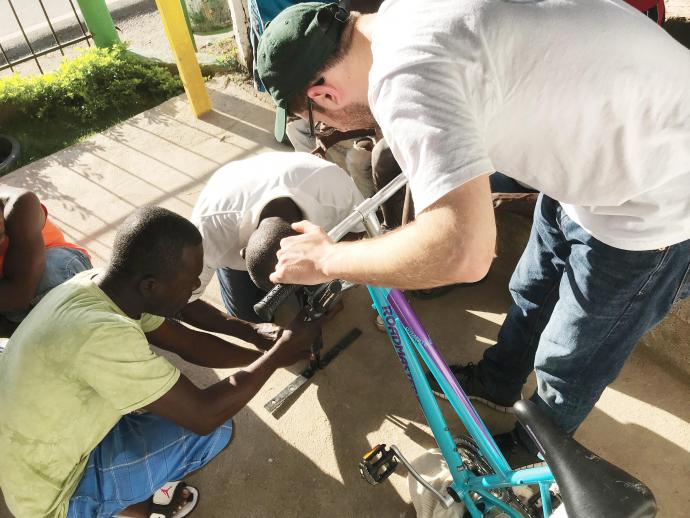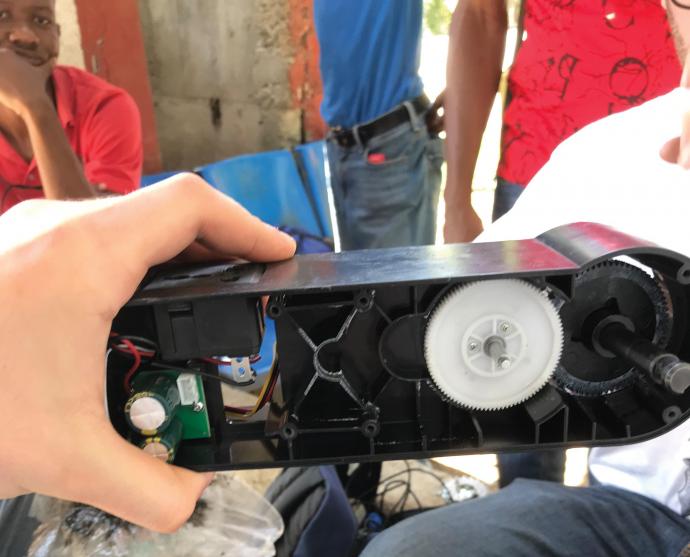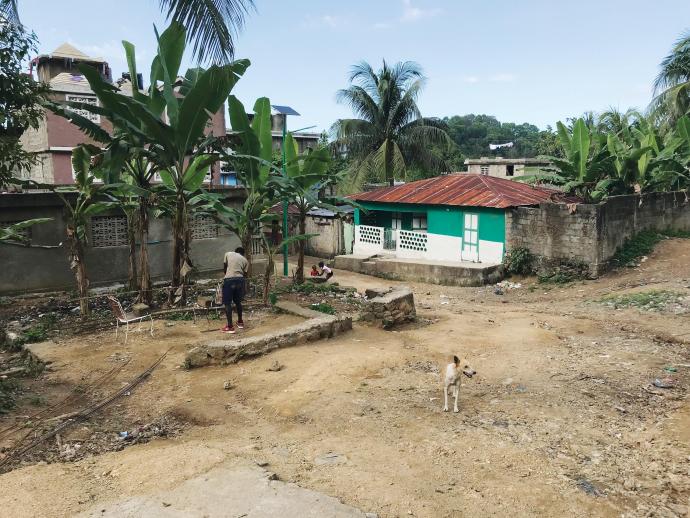Pedaling for Power on a Modified Bike in a Remote Haitian Village
The technology that engineering students Matt Reda and Rudolph Brazdovic installed last year in the remote, hilly community of Milot, Haiti, was simple enough: a modified bicycle with a back wheel that turns a generator, producing 20 watts of electricity. What was less straightforward, they quickly learned, was how to manage it.
Unlike devices for individual dwellings, such as water filters, the NJIT Light Cycle is a public service: a cellphone charging station for the approximately 50 people living within a mile of a regional gathering place.

DAY 1: Shortly after arriving in Milot, the NJIT Engineers Without Borders team begins assembling the student-designed cellphone charging device, known as the Light Cycle, at the taxi station designated by the villagers to house it.
“Once we left, the residents had to take responsibility for it — to operate the machine properly so it didn’t break down, to maintain it, to allocate the service fairly and to guard against theft,” explains Reda, president of NJIT’s chapter of Engineers Without Borders and the cycle’s lead designer. “We needed to set it up like a business, and this was something we hadn’t thought about while we were designing it back on campus in New Jersey.”
The pedal-powered generator helps to bridge a major infrastructure gap in the farming region a few miles from Haiti’s northern coast. There is no electrical power in Milot, and yet nearly everyone has a cellphone. For years, residents have been traveling by “tap-tap” — a motorbike with a trailer for passengers — 10 miles, or approximately a half hour, to the much larger Cap-Haitien in order to charge their phones. Many of them own 15-year-old flip phones with tiny batteries.
Reda’s and Brazdovic’s first task was to identify a safe and central place to install it; they chose the tap-tap station, an afterwork rendezvous for finding friends and catching up on local news. The team then needed to find and train someone to run it during the day at a steady “casual stroll,” as Reda puts it, so that it wouldn’t burn out, and to take the generator home at night for safeguarding. Local leaders chose a manager who was then involved throughout installation and testing.
DAY 2: A small crowd assembles as team members mull one of the first substantial decisions: the optimal number of chargers to build into the device. They opted for a high amperage charging block that powers up one phone at a time, but very quickly.
The contraption produces electricity through a generator mounted on the bike frame. The pedals are connected to a sprocket and chain, which turns the sprocket on the back wheel. With the back tire removed, they attached a second sprocket and chain to the generator on the frame. The gearing from sprocket to sprocket to generator is calculated to give the proper gear ratios to spin the generator at the appropriate speed. The generator is mounted in a way that it can be removed at night and remounted in the morning.
“Our innovation is the combination and the application of the technique. People have been making electric generators for a long time; ours is designed for safe positioning and for the ability to produce power out of a wall outlet,” Reda says.
Once in Milot, they worked with residents to secure the bike onto the concrete slab of the tap-tap station and to figure out how to optimize it for local needs. They then held training sessions for the five main participants and for another 15 to 20 people assisting in more minor roles.

DAY 3: The team tinkers with the Light Cycle’s generator, adding lubricant and attaching gears.
The settled part of the region, composed largely of one-story concrete buildings, is surrounded by fields spotted here and there with bananas, mangoes, citrus fruits, cocoa and coffee. The community is perfumed by the scent of lime trees and harvested cocoa beans drying on the town’s black streets. There are national landmarks nearby such as the 19th-century Sans Souci Palace built by Henri I, now a graceful ruin, that are viewed as potential tourist destinations.
“There is a lot of construction in Milot — our host wants to build guest houses, for example — and people need to communicate,” he notes.
NJIT students have been making engineering trips to Milot for more than a decade, bringing sustainable systems for human waste, energy and water purification, including a portable clay pot filter that runs water through sand and gravel.

DAY 4: The NJIT students take a day off while Milot residents practice operating the cellphone charging station. They conduct an audit of about 20 bio-sand water filters built and distributed throughout the village by a previous Engineers Without Borders team from NJIT.
“With our filters, the key was to develop an efficient production method that yields consistently performing filters with the use of locally available material and simple, inexpensive tools,” notes Jay Meegoda, a professor of civil and environmental engineering, and adviser to the student chapter. “With the Light Cycle, the aim was to provide an inexpensive energy source to be used day or night and rain or shine to charge their cellphones.”
The team plans to refine the service over the coming months.
“One of the best ways to ensure buy-in and compliance is to provide incentives for the people who run it and use it. We are still debating a number of elements, including fees, the merits of expansion and whether it’s best to have a few larger units that would be managed or multiple smaller units,” Reda says. “We plan to continue our involvement with the community as these issues are decided and implemented.”
DAY 5: After final testing, NJIT engineers (Matthew Reda, left, and Rudolph Brazdovic, fourth from left) officially hand off the Light Cycle to the Milot team. Several weeks later, they were pleased to hear it was running well and are now working on an improved model “for the next trip down,” Reda says.